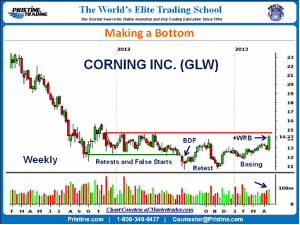Bottoms form in different ways, but if you learn to read price action instead of relying on indicators, eventually you will be able to identify them, writes Greg Capra of Pristine Capital Holdings, Inc.
This stock isn't going to be the next big mover like Apple (AAPL) was in its heyday, but it has formed a bottom and signaled the start of a move higher last week. Bottoming formations take time, and typically, have multiple retests of prior lows, breakdown failures (BDF) and false starts. One signal that has had a high degree of not being a false start coming out of a base is the bullish wide range bar (+WRB) on increasing volume.
After falling lower with virtually no bounces at all in 2011, Corning Inc. (GLW) began to form a bottom. Like most bottoming formations, GLW had its retests, failed attempts to move higher, (none ever cleared any prior highs) and a breakdown failure that was retested. Notice after the move up from that retest, GLW based sideways at resistance.
Pristine Tip: Basing at resistance after a move up signals buyers absorbing the supply and bullish.
Last week, GLW formed a +WRB with increasing volume and closed above its recent resistance area. Look further to the left, and you will see other large green candles, some even with an increase in volume, but none of them cleared prior highs. Those prior highs still have to be overcome; however, the price action that has occurred after them suggests that is going to happen.
By putting together the parts of the overall price action that has occurred, we have the makings of a bottom and bullish signal. I could have put a few indicators on the chart to show you how they are becoming bullish and signaling a move higher also. Most likely, that would create a belief in those indicators as a reliable way of determining a bottom. In time, you would be moving onto the next indicator someone else used. This is the cycle most go through forever and never understand how to read the interaction between buyers (demand) and sellers (supply).
Bottoms form in different ways, but if you learn to read the price action the way I've explained, you will be able to determine when that has happened. Whether you trade stocks, commodities, currencies, or the market indices learn to read the price action, not indicators that attempt to read the price action for you.
By Greg Capra, President & CEO, Pristine Capital Holdings, Inc.



















